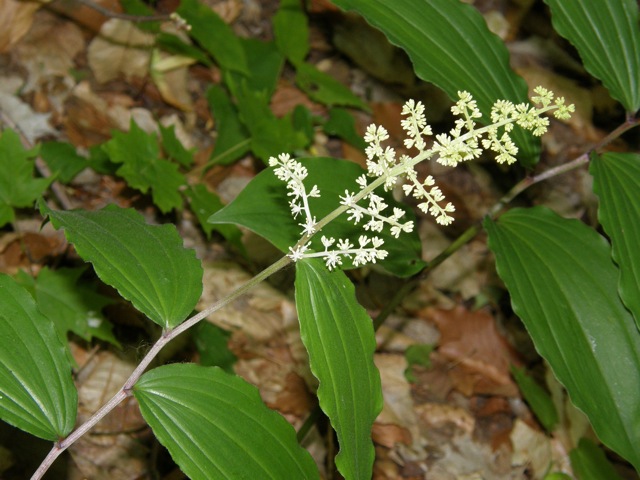Ruscaceae, the ruscus family; sometimes placed in Asparagaceae, the asparagus family; formerly Liliaceae, the lily family.
Description:
Plant:
Arching forest plant with distinctively parallel-veined, alternate leaves,
and terminal cluster of tiny, creamy-white flowers, growing from an underground rhizome.
Perennial.
Flowers:
Creamy white, small, about 1/8" across, with a starburst-like appearance due to three petals
three petal-like sepals, and six stamens,
and forming a pyramidal, terminal cluster, technically a compound raceme, or pannicle.
Leaves:
Alternate, elliptical, 3"-6" long, with conspicuous parallel veining and smooth margins.
Edges and lower surfaces have fine hairs.
The equal spacing and uniform orientation of the alternate leaves along the arching stem
makes this plant quite distinctive in appearance.
Fruit:
A cluster of berries that start out green with red speckles, and eventually become pure red.
Blooming:
May-June
Habitat:
Deciduous woods
Comments:
The naming and classification of this plant has been in flux over the last decade.
The information given here was the most widely accepted circa 2009.
The true Solomon's Seals, (Polygonatum sp.) are in the same family,
and have similar habit, but differ in having flowers in small clusters hanging from the
leaf axils rather than in a terminal cluster.
The common name refers to the circular scars on the rhizomes of the true Solomon's Seals.
These rootstocks are supposedly edible, in both varieties, if soaked in lye to remove
various unpleasant characteristics (and boiled to remove the lye).
The unfurling leaves can supposedly be eaten like asparagus.
As the plants are generally sparsely distributed, such experimentation is likely to be destructive
to the population.
The berries are bitter-sweet, and somewhat cathartic.
Where to find it:
Scattered through the upper woods of the park.
